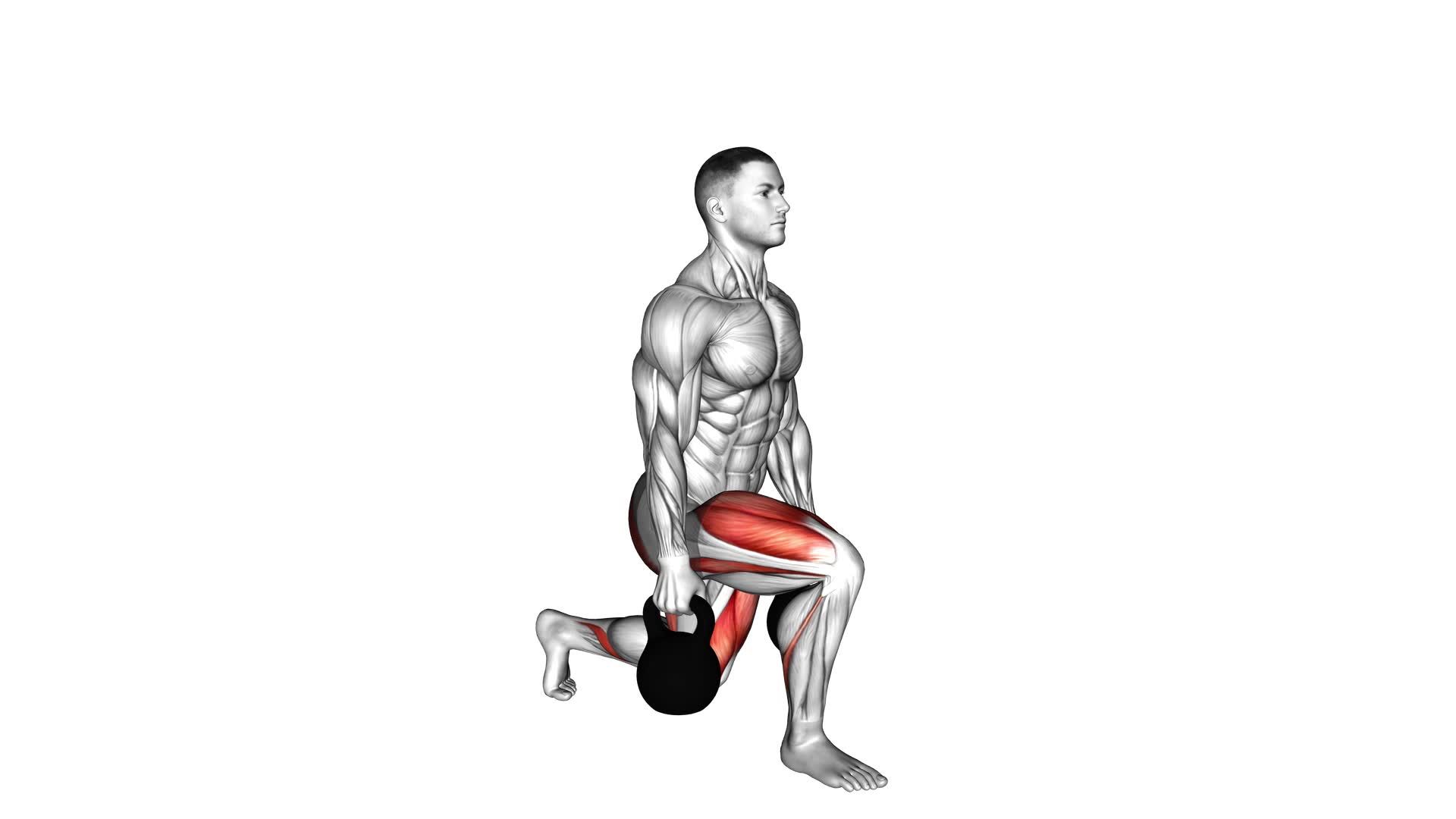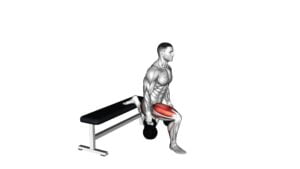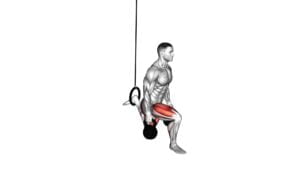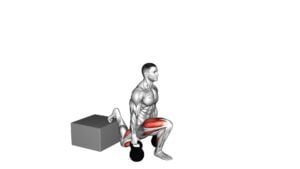Kettlebell Split Squat – Video Exercise Guide & Tips

Are you looking for a challenging lower body exercise that delivers results? Look no further than the kettlebell split squat!
Watch This Exercise Video
This video exercise guide and tips will show you the proper form, benefits, and variations of the kettlebell split squat. Avoid common mistakes and learn how to progress for a safe and effective workout.
Get ready to sculpt and strengthen your legs with this dynamic exercise. Let's dive in and maximize your fitness routine!
Key Takeaways
- Kettlebell split squat targets multiple muscle groups simultaneously, including the quadriceps, hamstrings, glutes, core, calves, and hip stabilizer muscles.
- It improves balance, stability, and coordination.
- Adding resistance with a kettlebell enhances muscle activation.
- Proper form is crucial to avoid common mistakes such as improper alignment of knees and ankles, leaning too far forward, and using too heavy of a kettlebell.
Proper Form for Kettlebell Split Squat
To perform a kettlebell split squat with proper form, start by positioning yourself in a split stance with one foot in front of the other. This exercise targets multiple muscle groups, including the quadriceps, hamstrings, glutes, and core. To maximize muscle activation and prevent injury, it's important to maintain proper form throughout the movement.
To modify the kettlebell split squat, you can start by using a lighter weight or no weight at all. This allows you to focus on mastering the movement and maintaining balance. As you become more comfortable, you can gradually increase the weight of the kettlebell.
To activate the muscles effectively, begin by engaging your core and keeping your torso upright. As you lower your body into the squat position, make sure your front knee stays aligned with your toes and doesn't extend past them. Your back knee should be lowered towards the ground, but avoid touching it to the floor.
Benefits of Kettlebell Split Squat
One major benefit of performing the kettlebell split squat is that it targets multiple muscle groups simultaneously. This exercise helps to improve your balance by challenging your stability and coordination. The split squat primarily targets the quadriceps, hamstrings, and glutes, but it also engages the core, calves, and hip stabilizer muscles. By using a kettlebell, you add an extra level of resistance, which further enhances the muscle activation.
The split squat is an excellent exercise for targeting different muscle groups because it requires you to work one leg at a time. This unilateral movement helps to correct any muscle imbalances that may exist between your legs. By focusing on one leg at a time, you can ensure that each leg is equally strong and functional.
In addition to targeting multiple muscle groups, the kettlebell split squat also challenges your balance. Holding a kettlebell in front of your chest while performing the movement forces your body to stabilize itself, enhancing your balance and coordination. This can be especially beneficial for athletes who need to maintain stability and control during dynamic movements.
Common Mistakes to Avoid
Avoid these common mistakes when performing the kettlebell split squat to maximize your results and prevent injury. Proper form is crucial for avoiding injuries and getting the most out of this exercise.
One common mistake to avoid isn't maintaining proper alignment. Make sure your front knee is directly above your ankle and your back knee is hovering just above the ground. This will help protect your knees and prevent strain.
Another mistake to avoid is leaning too far forward. Keep your torso upright and engage your core to improve balance and stability.
Additionally, avoid rushing through the exercise. Take your time and focus on controlling the movement to ensure proper form and prevent injury.
Lastly, avoid using too heavy of a kettlebell. It's important to start with a weight that allows you to maintain proper form throughout the exercise.
Variation and Progression of Kettlebell Split Squat
As you progress in your kettlebell split squat routine, there are several variations you can incorporate to challenge your muscles and continue making gains. These advanced variations not only provide a greater challenge but also increase muscle activation, leading to improved strength and stability.
One advanced variation is the kettlebell split squat with a pause at the bottom. Instead of performing the exercise in a continuous motion, you hold the bottom position for a few seconds before returning to the starting position. This pause increases the time under tension, further activating your leg muscles and enhancing muscle growth.
Another variation is the kettlebell split squat with a kettlebell swing. As you descend into the split squat position, you swing the kettlebell between your legs and explosively extend your hips as you stand up. This dynamic movement not only targets your leg muscles but also engages your glutes and core, providing a full-body workout.
Lastly, you can try the kettlebell split squat with an overhead press. Holding a kettlebell in each hand, you perform the split squat while simultaneously pressing the kettlebells overhead. This variation not only challenges your lower body but also engages your shoulders, arms, and upper back, making it a great exercise for total body strength.
Incorporating these advanced variations into your kettlebell split squat routine will keep your workouts challenging and effective. Remember to start with lighter weights and gradually increase the load as you become more comfortable with the movements.
Tips for a Safe and Effective Workout
To ensure a safe and effective workout, follow these three tips.
First, it's essential to warm up before performing a kettlebell split squat. Warming up helps increase blood flow to your muscles, preparing them for the exercise and reducing the risk of injury. Start with some light cardio exercises like jogging or jumping jacks to raise your heart rate and loosen up your joints. Then, perform dynamic stretches that target the muscles you'll be using during the split squat, such as lunges or leg swings.
Next, choosing the right kettlebell weight is crucial for your fitness level. It's important to challenge yourself, but also to maintain proper form and technique. If you're a beginner, start with a lighter kettlebell and focus on mastering the movement before increasing the weight. As you become more comfortable and stronger, gradually increase the weight to continue challenging yourself.
Remember, safety should always be a priority during your workout. If you experience any pain or discomfort, stop immediately and consult a fitness professional.
Frequently Asked Questions
How Much Weight Should I Use When Performing the Kettlebell Split Squat?
When performing the kettlebell split squat, it's important to choose a weight that challenges you but allows you to maintain proper form. As you progress in weight, start with a weight that you can comfortably perform 8-12 reps with. Gradually increase the weight as you become stronger.
Kettlebell split squats are beneficial for lower body strength as they target multiple muscle groups including the quads, glutes, and hamstrings. Incorporating progressive overload will help you continue to see improvements in your strength and muscle development.
Can I Replace the Kettlebell With a Dumbbell or Other Weighted Object?
Yes, you can replace the kettlebell with a dumbbell or other weighted object for the split squat exercise. However, there are some differences between the kettlebell split squat and the dumbbell split squat.
The kettlebell offers a unique grip that can challenge your core stability and grip strength. Additionally, the offset weight distribution of the kettlebell can further engage your muscles.
Nevertheless, the dumbbell split squat can still provide a great lower body workout and help improve balance and strength.
Should I Perform the Kettlebell Split Squat on Both Legs or Just One?
To get the most out of your kettlebell split squat, it's important to perform the exercise on both legs. This ensures that you're working both sides of your body evenly and helps to improve balance and stability.
Unilateral leg exercises like the split squat have many benefits, including targeting individual muscles, improving strength imbalances, and enhancing overall athletic performance.
If you're looking for variations, you can try using dumbbells or other weighted objects instead of a kettlebell to add variety to your routine.
Can I Incorporate the Kettlebell Split Squat Into My Regular Leg Workout Routine?
Yes, you can definitely incorporate the kettlebell split squat into your regular leg workout routine. By adding this exercise, you'll experience several benefits. Kettlebell exercises engage multiple muscles, improving strength, stability, and balance.
To perform the kettlebell split squat effectively, start with one foot forward and the other foot back, holding the kettlebell by the handle. Lower your body down into a lunge position, keeping your front knee above your ankle and your back knee hovering just above the ground. Push through your front heel to return to the starting position.
How Often Should I Perform the Kettlebell Split Squat Exercise for Optimal Results?
For optimal results, you should perform the kettlebell split squat exercise regularly.
The frequency of the kettlebell split squat will depend on your overall fitness goals and current workout routine.
Incorporating this exercise two to three times a week can help improve lower body strength, stability, and balance.
It also targets muscles such as the quadriceps, glutes, and hamstrings.
Conclusion
In conclusion, the kettlebell split squat is a highly effective exercise that targets multiple muscle groups and improves stability, strength, and balance.
By following proper form and avoiding common mistakes, you can maximize the benefits of this exercise.
Gradually increasing the difficulty level and incorporating variations will help you progress and challenge your muscles even further.
Remember to always prioritize safety and listen to your body during your workouts.
With consistent practice, the kettlebell split squat can be a valuable addition to your fitness routine.

Author
Years ago, the spark of my life’s passion ignited in my mind the moment I stepped into the local gym for the first time. The inaugural bead of perspiration, the initial endeavor, the very first surge of endorphins, and a sense of pride that washed over me post-workout marked the beginning of my deep-seated interest in strength sports, fitness, and sports nutrition. This very curiosity blossomed rapidly into a profound fascination, propelling me to earn a Master’s degree in Physical Education from the Academy of Physical Education in Krakow, followed by a Sports Manager diploma from the Jagiellonian University. My journey of growth led me to gain more specialized qualifications, such as being a certified personal trainer with a focus on sports dietetics, a lifeguard, and an instructor for wellness and corrective gymnastics. Theoretical knowledge paired seamlessly with practical experience, reinforcing my belief that the transformation of individuals under my guidance was also a reflection of my personal growth. This belief holds true even today. Each day, I strive to push the boundaries and explore new realms. These realms gently elevate me to greater heights. The unique combination of passion for my field and the continuous quest for growth fuels my drive to break new ground.







